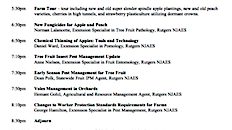Click to View | Download Report 5-5-16 Potato Disease Forecasting Report We will be tracking DSVs for Late blight development and calculating P-days for initiating the first early blight fungicide application. The first late blight fungicide application is recommended once 18 DSVs accumulate from green row. Green row typically occurs around the first week in May […]
Continue reading...Orondis, a new Fungicide from Syngenta
Syngenta Crop Protection released Orondis, a new fungicide with a new mode-of-action for use in vegetable production this past winter. Because of its winter registration, Orondis was not included the 2016 Mid-Atlantic Commercial Vegetable Production Guide. Orondis (oxathiapiproplin, U15) targets the oxysterol binding protein that is a part of the fungal cell wall. The active […]
Continue reading...North Jersey Tree Fruit: May 10, 2016 On-Farm Twilight Meeting

Date: May 10, 2016 5:30pm Location: Ken Wightman’s Farm, 1111 Mt. Kemble Ave, Morristown, NJ Fruit growers and industry are invited to the North Jersey Tree Fruit Twilight Meeting on May 10 5:30 PM at Ken Wightman’s Farm. The program includes: Wightman Farm orchard tour, fungicide update, chemical thinning of apple, and early season […]
Continue reading...New Downy Mildew Grant Award will Aid Growers
For the past 6 years, Rutgers has led efforts in the breeding of sweet basil for resistance to downy mildew. Currently, basil downy mildew threatens 100% of the basil acreage in the US and other parts of the world. Rutgers University, along with researchers at Michigan State, University of Florida, Oregon State University, Cornell University, […]
Continue reading...Got humidity? Get rid of it!
Unfortunately, closed greenhouses retain heat and humidity which can spell problems if left unchecked. Remember, high relative humidity equals wet leaves which favor the development of fungal diseases such as Botrytis or bacterial diseases such as bacterial leaf spot. To avoid potential problems, do your best to vent out as much humidity as possible in the […]
Continue reading...Wet Weather Ripe for Strawberry Fruit Rots
Fruit rots in strawberry can cause significant losses if not recognized early and controlled. The use of good cultural practices such as: keeping fields weed-free and promoting good drainage; long crop rotations, and preventative fungicide applications are critical. Pathogens such as anthracnose, gray mold (Botrytis), and leather rot can become systemic problems in strawberry plantings […]
Continue reading...